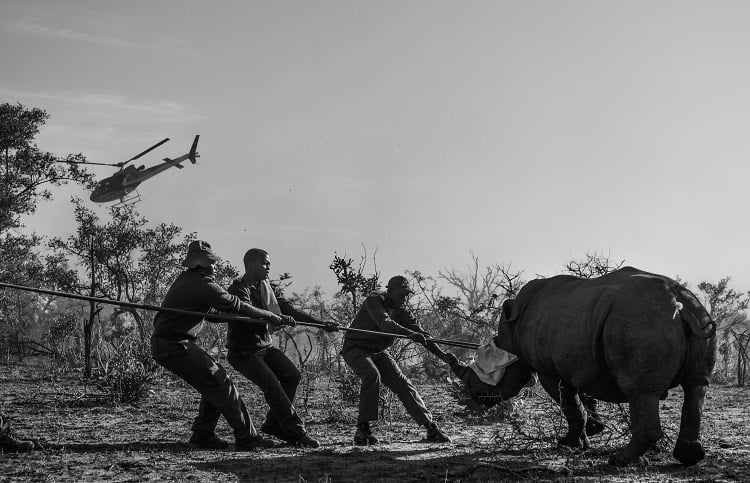Posted on May 30, 2017
The reality of rhino poaching has made us all too aware of the fragility of the species. It is with growing frequency that veterinary professionals are required to work on these animals in an attempt to save them. Intervention varies from conducting the necessary steps to make a translocation possible, to efforts to save an animal that has sustained a poaching attack, to other veterinary procedures like dehorning.
Rhinos' response to immobilisation (anaesthesia) has proved to have complications, but Prof Leith Meyer from the Department of Paraclinical Sciences in the Faculty of Veterinary Science at the University of Pretoria, is constantly working to better understand how these iconic animals respond to immobilisation. Thus far, Meyer's research has isolated the drugs that work best to stabilise white rhino and found ways to improve blood oxygen levels in the immobilised animal.
When immobilised, rhino – particularly white rhino – experience tremors that are sometimes so severe that it is very difficult to work on them. The cause of these tremors was not clear until Meyer and his team set out to understand them and whether cardiorespiratory supportive interventions alter their intensity. The study looked at the possible mechanisms that lead to muscle tremors and physiological responses during etorphine–azaperone immobilisation in eight boma-held and 14 free-living sub-adult male white rhino in the Kruger National Park. The reason for the two groups was to test whether the interventions that worked best on boma-held rhino had similar results in the free-living rhino. Sub-adults were chosen because they would not yet have become territorial, and by removing them temporarily from the wild, the social structures of other rhino would not be affected.
One of the objectives of the study was to develop a model that grades the severity of these tremors. Tremors were measured using a tremor scale and activity loggers which were able to measure even the slightest movements. Loggers were attached to the shoulder and leg of each animal to monitor tremors and the differences in readings – often the leg logger picked up too much movement, which is not always a result of the tremors, but rather general movement of the leg.
Meyer's research has proven that white rhino are particularly sensitive to the drugs used during immobilisation. These drugs tend to depress their breathing and also have metabolic effects which cause the sedated animals to burn up oxygen more quickly. Because they are not breathing properly while under the drugs, they are not able to supplement the deficit. 'Arterial blood that goes to the tissues ends up being very low in oxygen, resulting in the animal becoming severely hypoxic,' explains Meyer. Furthermore, these drugs cause high levels of carbon dioxide and increase the acidity of the blood. During times of hypoxia and acidaemia, oxygen deprivation causes the body to go into survival mode, releasing stress hormones (catecholamines), such as adrenaline, into the blood. Just as in humans after getting a big fright, the body begins to shake.

Photo by Joel Alves, a veterinary student in the Faculty of Veterinary Science
The stress from the helicopter chase is likely to also cause the rhino to produce more heat than it dissipates, which can lead to hyperthermia. The increased heat produced from the tremors, can worsen the hypoxia and acidaemia, causing severe respiratory and metabolic consequences.
While it is imperative to react to the tremors, they do serve as a useful tool to monitor how the animal is doing. Severe tremors serve as a warning sign that something is physiologically wrong, and suggest that the animal is compromised.
Intervention to reduce the intensity of the tremors is necessary. Oxygen levels need to be restored and carbon dioxide needs to be expelled to improve the pH level of the blood. The drug butorphanol improves the flow of gases in the blood and reduces the severity of tremors. 'By providing oxygen intranasally, oxygen levels can be brought back to normal, which slows the tremors significantly, even stopping them completely,' says Meyer. Administering intravenous butorphanol is a simple, readily available technique that will significantly improve oxygenation, thereby reducing tremors and improving the safety of white rhino immobilisation in general.
Meyer is continuously trying to understand all possible scenarios to reduce the risks to rhino when immobilised. 'We have to do these tests now while we still have many rhino, because if they do get to the stage where they become critically endangered, if we do not understand how they react to anaesthesia, we may have a very serious problem.' He aims to make anaesthesia as safe as possible for rhino.
Copyright © University of Pretoria 2024. All rights reserved.
Get Social With Us
Download the UP Mobile App